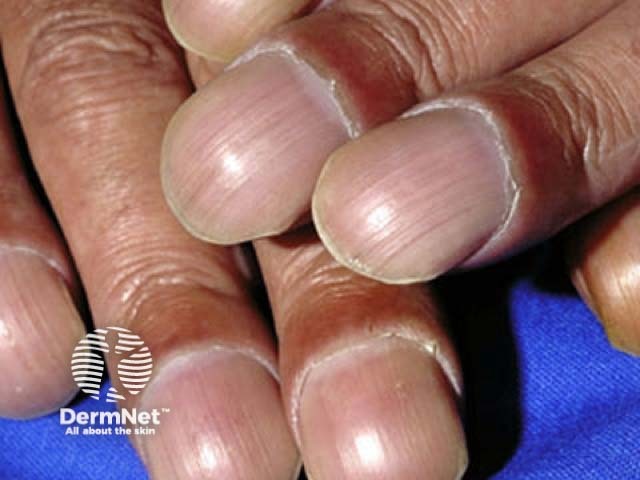Main menu
Common skin conditions

NEWS
Join DermNet PRO
Read more
Quick links
Author: Vanessa Ngan, Staff Writer, 2004. Updated by A/Prof Amanda Oakley, February 2016.
Introduction Demographics and causes Associated diseases Clinical features Diagnosis Treatment
Hypertrophic osteoarthropathy is a disease of the joints and bones. It is characterised by clubbing of the fingers and toes, enlargement of the extremities, and painful and swollen joints. The disease falls into 2 categories:
Primary hypertrophic osteoarthropathy is a rare inherited condition. In most cases it develops over a period of time and is essentially symptomless. Initial visits to doctors are usually for minor pains in the shoulders and hands.
Patients with secondary hypertrophic osteoarthropathy usually complain of pain and swelling in joints and long bones, and clubbing of fingers. The symptoms occur suddenly and progress rapidly. Approximately 90% of these cases have an underlying malignancy; the remainder have non-malignant chronic diseases of the lungs, liver or heart.
Features of secondary hypertrophic osteoarthropathy include:



Primary hypertrophic osteoarthropathy is a rare hereditary condition.
Secondary hypertrophic osteoarthropathy is most often associated with an internal malignancy or chronic disease. Peripheral non-small cell lung cancer is the most commonly associated malignancy in patients with secondary hypertrophic osteoarthropathy. The underlying malignancy or disease usually appears first, although in some cases the symptoms of hypertrophic osteoarthropathy have preceded the underlying disorder by more than one year.
The actual cause of hypertrophic osteoarthropathy remains unclear. Oestrogens, circulating factors, neurogenic factors and growth hormone are all thought to play a role.
Clubbing can also be seen as an isolated abnormality in patients with lung and/or heart disease, and rarely gastrointestinal disease, hyperthyroidism and other diseases. Examples include:
To determine if clubbing is present, flex the fingers of both hands. Bring the index fingers together until the distal phalanxes are touching. A diamond space between them (Schamroth's window) means the nails are not clubbed (Schamroth's sign).

Schamroth window
Clubbing is associated with:
Hypertrophic osteoarthropathy is diagnosed by the presence of nail clubbing in associated with typical radiological signs on plain X-ray.
The main aim of treatment for secondary hypertrophic osteoarthropathy is treatment of the underlying malignancy or chronic disease. Removal of the underlying tumour usually results in spontaneous improvement of bone and joint symptoms within 2-4 weeks. Clubbing is unlikely to be reversed if substantial chronic tissue changes, including increased collagen deposition, have occurred. Nonsteroidal anti-inflammatory drugs may be helpful for relieving painful osteoarthropathy.
Treatment of isolated clubbing is of the underlying cause.